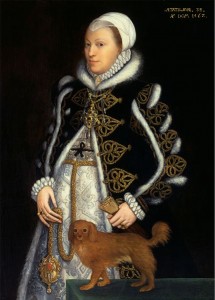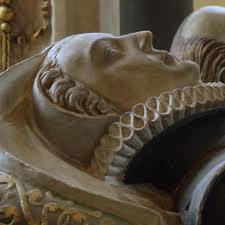
Today we have a guest post from Natasha Gennady Robinson, part one of a two-part series. Thank you so much, Natasha, for writing this wonderful article for us. Over to Natasha…
There is but one portrait said to be of Catherine Knollys (née Carey), though as with the current trends, many historians seek to dispel it. Claiming there is no proof, no other physical basis for comparison, and yet there still exists the effigy of Catherine Knollys, that which she shares with her husband Francis Knollys in the Church of St. Nicholas at their first family estate Rutherford Greys (aka Rotherfield Greys) in Oxfordshire. There is also correlation of the portrait known as The Van Meullen Portrait, named for its artist, and the recently surfaced Latin Dictionary once belonging to Francis Knollys, in which the long-lived Elizabethan courtier recorded the dates of his marriage to Catherine Carey, and that of the births of their fourteen children. These dates co assign perfectly with the inscription of the Van Meullen portrait, stating the subject’s age as thirty-eight (or in her thirty-eighth year, which only makes it a little less credible) and the year of the portrait’s execution as 1562. The subject’s bountiful pregnant belly also correlates with the date of birth of her last child, Dudley.1 But there is, in fact, one more proof, and that lies in the lady’s adornments. About her waist, upon a thick and rich golden girdle chain, we find a medallion featuring a male figure, before him a crimson shield, and in his hand a spear. It would seem to the untrained eye irrelevant, but holds more proof in detail than ever the dating of the portrait alongside the lady’s age, for it reveals in its symbolism the true career of Catherine Knollys’ beloved husband.
Francis Knollys, a man who started his courtly career as a groom to Henry VIII, was married at a decidedly young age to Catherine Carey, who may or may not have been the natural daughter of his King, and was so rewarded for his marriage by the relegation of his father’s defunct estate, Rutherford Greys (aka Rotherfield Greys), as well as the annuity of additional properties and a license to trade in large amounts of bell metal.2 And atop all this favour, Francis was given a yearly annuity as one of the King’s Gentlemen Pensioners. But what of this ‘pension’? Well there lies more in this title than would outwardly appear, and yet within this lesser known prestige, there lies also a treasure trove of facts, holding the key to many great Tudor mysteries. Some of which even the greatest Tudor historians to this day largely ignore. For the Gentlemen Pensioners, or The King’s Honourable Band Of Gentlemen Pensioners as they are known in full, were more than a group of men favoured with a yearly annuity by their King, they were, in fact, the King’s own self-appointed body-guard, which remain virtually unaltered as a faction of royal bodily protection to this day.
Chosen in its first instance, from Henry VIII’s own household, this group of fifty men held great favour and esteem, and in their vocational requirement of being ever within close personal proximity to the King (and or Queen), great trust.3
Even still, of the surviving primary sources, very few make recording or reference to the faction in its fully developed state, which in some likelihood may be due to the shrouding of secrecy the faction required, or simply due to the constant metamorphoses of the faction’s title. Yet there are links that appear with some consistency. Within the Letters and Papers of April 1539, there is reference to The Men Of The Spears with a group of fifty men named in order of preference. Amongst the lists, appears the name of Francis Knollys, but even better still, there also appears the name of Catherine Carey’s stepfather William Stafford, second husband of the infamous Other Boleyn Girl, Mary. These Men Of The Spears here appear under the more discerning title, The Royal Body Guard, showing more evidently the true nature of the faction.4
Within the Chronicle Of Calais, we find the same group of men, though some names have been removed and added, amongst the long lists of those chosen to attend the reception of King Henry VIII’s fourth Queen, the German princess, Anne of Cleves. Here the Gentlemen Pensioners are referred to as being For My Admiral’s Despatch, and while the majority of courtiers either great or low in station would stay in England to meet the new Protestant Queen on home soil, the Gentlemen Pensioners would be sent to Calais to receive Anne of Cleves, and so bring her safely across the water to her marital destiny.
In fact the earliest surviving evidence of this faction of gentlemen is within the Domestic State Papers on 25th January 1537, where a letter to Lord Lisle (The Admiral of Calais noted) is sent regarding the appointment of “l. speres made which shall have xl. Il. the spere yerly….a nyw order in takyn in the Kynges howsse, and that the most part shall have pencyons.”5
But that was by no means the true date of the original instigation of the faction. For we find in Hall’s Chronicle, that there was, on the insistence of King Henry VIII’s good friend William Compton,6 a royal body-guard begun and appointed in the first year of Henry’s rule, then known as The Corps Of The Spears Of Honour, instigated in 1509. Apparently the first instatement of this new creed of Yeoman of the Guard, as was the previous title for armed men who surrounded a King for his own protection, was very short-lived, for nothing more appears of it after 1514. As Hall then reasons, that first group of Spears manned by the King’s favourite nobles, then fell under the weight of expense the faction required, for never were there men more richly uniformed, and paid, than those first Royal Guards of England’s most sumptuous King.7

The re instatement of the Royal Guard, developed some thirty years later, was engineered for success with one great difference, and that was that the men appointed would be of ignoble, or common birth. Hence the title ‘Gentlemen’. The new Guard’s power of economy clearly bears the mark of Thomas Cromwell, Earl of Essex, Henry’s most successful Lord Chancellor, who was as inventive as he was shrewd. And as it appears in the first instance, Cromwell was also the original Lieutenant of King Henry VIII’s Gentlemen Pensioners.8
The new lowered class requirement of admission to the band not only saved the King money, but ensured better service, for these low men would also be more experienced with hand to hand combat, and on a less admirable note, more personally expendable at the event of their death in service.9 The men would then, after having given service to the protection of their King, in the greater part, be installed into the English Army.
Perhaps the most richly elaborate source of primary information regarding the Gentlemen Pensioners is the transcript of the original Statutes and Ordinances, as well as the original Oath, taken down and signed by the hand of King Henry VIII himself. And time and again within these ordinances do we find the specifications for the uniform of the Pensioners, “coats of red and white” or “in suit of red and yellow damask or cloth of gold” “trapped in Clothe of Golde, Silvuer and Golde Smithes woorke”.10 And then there is the spear, that most telling tool, as much their namesake as it was their constantly required personal weapon. If this apparel all does sound familiar, it is because those same specifications of apparel, though crude in this particular description, still exist now with little alteration in the uniform of the current Royal Guard, still known as The Honourable Band Of Gentlemen Pensioners, despite nearly five hundred years of service to the English monarchy.
And here so lies our proof, for upon the afore-mentioned medallion, suspended from the golden girdle worn by the lady otherwise only vaguely believed to be Catherine Knollys, stands a man wearing most obviously the uniform of the Henrician Royal Guard known as The Honourable Band of Gentlemen Pensioners. And what pride did Catherine Knollys then feel towards her husband’s first prestigious royal post, that she might make use of its emblematic device, adorning her girdle as a mark of wealth of pride in her portrait painted some twenty years later. For despite the lack of nobility these men handpicked by their King for his own protection had at their instatement, their pride as members of such an elite band of gentlemen would surely abound with the courts utmost respect. And amongst this largely secretive faction of fifty low-born men, handpicked by King Henry VIII, we now know, was Catherine’s husband, Francis Knollys.
In Part 2 we discuss the cause for the re instatement of the Royal Body Guard by Henry VIII, and the factional requirements that in their details answer many questions of the reign of Henry VIII, as well as the Boleyn family, long thought to be forgotten.
Notes and Sources
- Varlow, Sally, Sir Francis Knollys’ Latin Dictionary; New Evidence For Katherine Carey, 2006, Blackwell Publishing, Oxford UK.
- L&P, July 1539
- Regia Insignia or An Account of The King’s Honourable Band of Gentlemen Pensioners or Gentlemen at Arms, Thistleton, W.M, pp3-5, 1819, Sherwood, London.
- L&P April 1539 783
- State Papers, Domestic, Henry VIII, Vol. XII, part 1. no. 337 25th January 1537.
- Dugdale’s Baronage And Observations On The Life Of Thomas Howard Earl Of Surrey.
- The Spears of Honour And The Gentlemen Pensioners pp. 2-3. John Glas Sandeman. 1912 Higgingbottom.
- Quoting Hall’s Chronicle, Regia Insignia, p 3.
- The Spears of Honour And The Gentlemen Pensioners p. 4.
- Regia Insignia, Quoting Hall, p. 3.